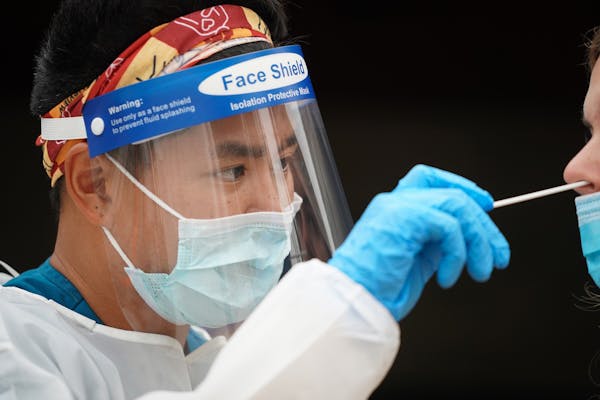The White House's top COVID-19 adviser urged Minnesotans to buckle down and reduce the spread of the infectious disease before winter weather crams everyone indoors and transmission risks increase.
Dr. Deborah Birx was in St. Paul on Sunday to meet with state officials, first with Gov. Tim Walz then with health and policy leaders.
Much of the attention to reduce the spread of the virus has been focused on restaurants and public places, but people need to take the same precautions in their personal and family gatherings, said Birx, the White House's coronavirus response coordinator.
"We're asking every Minnesotan to work really hard over the next four to six weeks to really bring these cases down," she said, "because when you have lower level cases, it's much easier to contact trace and get into those neighborhoods and find those asymptomatic spreads and really know you are containing the virus completely."
Minnesota right now is categorized by the Covid Exit Strategy website as "trending poorly" in its COVID-19 case growth, but neighboring states such as Iowa and the Dakotas have a worse rating of "uncontrolled spread" of the virus. Wisconsin also is listed as trending poorly.
Birx said she is concerned that the number of Minnesota counties with positivity rates of diagnostic testing above 10% has increased over the past month from two to nine.
Birx's team is visiting states one at a time — with Wisconsin and Illinois up next. Birx said she visited local hotels and restaurants to see if COVID-19 precautions were being taken seriously, and said she saw a level of attention in local establishments not seen in all other states.
One concern is that the initial urban spread of the virus has resulted in less compliance in rural areas, she said. "There is a real attention to these mitigation efforts in the urban areas, but there really does need to be improvement out in many of the rural areas."
Birx said she received a request from the governor to maintain flexibility in the federal CARES Act so that Minnesota could tailor its response to the pandemic. Walz spokesman Teddy Tschann said "they agreed that while Minnesotans have by and large worked hard to slow the spread of COVID-19, there is still work to be done."
Birx said she also talked with a leader of the Fond du Lac Reservation and noted the need to protect American Indians, who have the highest COVID-19 death rate of any racial group in the U.S.
In Minnesota, the COVID-19 death rate among American Indians is 151 per 100,000 people, compared with a rate of only 23 per 100,000 people among non-Hispanic white people, according to the Minnesota Department of Health.
The state on Sunday reported two more COVID-19 deaths and 934 new infections, with a total of 1,816 COVID-19 deaths and 75,189 lab-confirmed infections. New case numbers have been somewhat inflated over the past week by the overdue reporting of more than 10,000 diagnostic tests by one lab, but also by a recent increase in outbreaks related to large group outings, including weddings and parties and at bars and restaurants.
The state stepped up enforcement this weekend of its requirements that dining establishments limit their indoor service to 50% of their fire code capacities, require people to wear masks, and maintain social distancing.
Birx's visit is the latest step in an erratic relationship between Minnesota and President Donald Trump's federal administration when it comes to the COVID-19 response.
Walz has criticized Trump for the lack of a national COVID-19 response but has done so cautiously given the federal government's ability to outbid states on key supplies such as masks and gowns, and to manage state allocations of remdesivir for hospitalized COVID-19 patients.
Trump in April criticized the state's COVID-19 shutdown with a "Liberate Minnesota" tweet but then complimented the state days later after a phone call with Walz. He then sent Vice President Mike Pence to promote the COVID-19 research and treatment efforts at Mayo Clinic.
The U.S. Centers for Disease Control and Prevention also tapped Minnesota as one of four states to study how to eventually prioritize and distribute initial limited doses of COVID-19 vaccines.
The state on Sunday reported that 315 Minnesotans were hospitalized for COVID-19, including 136 people who needed intensive care. The number of hospitalizations had increased in July but leveled off in August.
State health officials are concerned that the start of K-12 classes and the reopening of colleges could result in a new wave of cases — with younger, healthier teenagers and young adults eventually spreading the virus to people at greater risk of severe complications.
More than nine in 10 COVID-19 deaths in Minnesota have involved people who are 70 or older or have underlying health conditions such as diabetes or heart disease.
The current CDC list of health conditions that complicate COVID-19 also includes cancer, chronic kidney disease, COPD, post-transplant immune system weakness, sickle cell disease and obesity. That puts a substantial share of Americans at elevated risk, given that the adult obesity rate in Minnesota alone exceeds 30%.
Birx said younger and healthier people do have some personal risks from COVID-19 — with some infections resulting in long-term health issues — but that they need to take precautions to protect others, including their own parents and grandparents.
"There's 81 million Americans with comorbidities," Birx said, "and so in order to protect the 81 million with comorbidities, you need to protect the 330 million from spreading the virus to those 81 million."
Jeremy Olson • 612-673-7744

A tale of 124 hoarded Minnesota cats has at least a hundred happy endings

Walz, St. Paul leaders urge support for copper wire theft bill: 'We've got to get in front of it'
Body of missing canoeist, 15, recovered from southwest Minnesota lake

High winds flipped a FedEx truck traveling on Bong Bridge in Duluth

